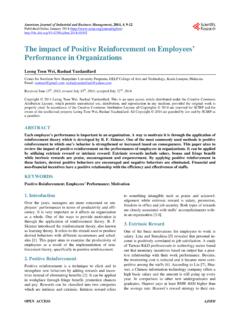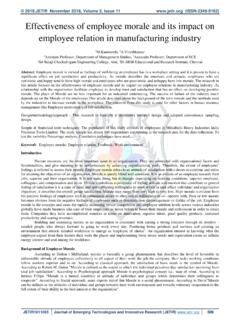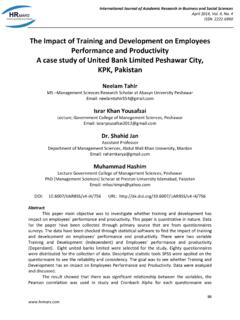Transcription of Two Decades of Research and Development in ...
1 TRANSFORMATIONAL LEADERSHIP9 1999 Psychology Press LtdEUROPEAN JOURNAL OF WORK AND ORGANIZATIONAL PSYCHOLOGY, 1999, 8 (1), 9 32 Two Decades of Research and Development inTransformational LeadershipBernard M. BassCenter for Leadership Studies, State University of New York,Binghamton, USAThe interests of the organization and its members need to be aligned. Such is a taskfor the transformational leader. In contrast to the transactional leader who practisescontingent reinforcement of followers, the transformational leader inspires,intellectually stimulates, and is individually considerate of them. Transformationalleadership may be directive or participative. Requiring higher moral Development ,transformational leadership is recognized universally as a concept. Furthermore,contrary to earlier expectations, women leaders tend to be more transformationalthan their male counterparts.
2 Although a six-factor model of transformational/transactional leadership best fits a diversity of samples according to confirmatoryfactor analyses, whether fewer factors are necessary remains an open important Research question that has only been partially answered is whytransformational leadership is more effective than transactional leadership in awide variety of business, military, industrial, hospital, and has been 20 years since Burns (1978) published his seminal work introducingthe concepts of transformational and transactional leadership. Whereas trans-formational leaders uplift the morale, motivation, and morals of their followers,transactional leaders cater to their followers immediate self-interests. Thetransformational leader emphasizes what you can do for your country; thetransactional leader, on what your country can do for you.
3 A considerable amountof empirical Research has been completed since then, supporting the utility of thedistinction. Changes in the marketplace and workforce over the two Decades haveresulted in the need for leaders to become more transformational and lesstransactional if they were to remain effective. Leaders were encouraged toempower their followers by developing them into high involvement individualsand teams focused on quality, service, cost-effectiveness, and quantity of outputRequests for reprints should be addressed to Bass, Center for Leadership Studies,State University of New York, Binghamton, New York, 13902-6015, USA: production. The end of the Cold War placed a premium on the flexibility ofemployees, teams, and organizations. Jobs for the less skilled were automated outof existence or exported to the Third World. Those jobs that remained requiredbetter education and shifted downward in the flattening organizational of educated professionals became commonplace.
4 Increasingly, pro-fessionals saw themselves as colleagues rather than in superior subordinaterelationships. Transformational leadership, which fosters autonomy andchallenging work, became increasingly important to followers job concept of job security and loyalty to the firm for one s entire career wasdisappearing. Steady pay, secure benefits, and lifetime employment were nolonger guaranteed for meritorious performance. At the same time, transactionalleadership alone could not provide job years ago in the United States, parents believed that it was mostimportant to teach their children to respect authority, to respect the church, torespect one s government, and to avoid questioning authority. Today parentsbelieve it is most important to teach their children to accept responsibility fortheir own actions, to be willing and confident in accepting challenges, and toquestion authority when necessary.
5 The conforming organizational worker of the1950s, totally dedicated to the firm, did not question authority. In the 1990s,much scepticism and cynicism has replaced the norms of unquestioningconformity of the the 1950s, going beyond one s self-interests for the good of theorganization was a norm of the organizational worker. That is, there was publicand expressed acceptance of organizational goals, possibly filled with privatereservations. There may have been a lot of expressed identification with theorganization s goals and even internalization of the organization s beliefs. Intoday s more cynical world, such going beyond one s self-interests for the goodof the organization requires aligning the individual members interests andvalues with those of the organization. Trust in the leadership is required forwillingness to identify with the organization and to internalize its values and theemergence in the workforce of transcendental organizational citizenship be-haviour (altruism, conscientiousness, sportsmanship, courtesy, and civic virtues)(Podsakoff, MacKenzie, Moorman, & Fetter, 1990).
6 For this, transformationalleadership is needed along with corresponding changes in selection, training, Development , and organizational Full Range of Transactional andTransformational LeadershipMuch has been done but more still needs to be done before we can fullyunderstand and confidently make use of the full range of transactional andtransformational leadership. Transactional leadership refers to the exchangerelationship between leader and follower to meet their own self-interests. It mayTRANSFORMATIONAL LEADERSHIP11take the form of contingent reward in which the leader clarifies for the followerthrough direction or participation what the follower needs to do to be rewardedfor the effort. It may take the form of active management-by-exception, in whichthe leader monitors the follower s performance and takes corrective action if thefollower fails to meet standards.
7 Or it may take the form of passive leadership, inwhich the leader practises passive managing-by-exception by waiting forproblems to arise before taking corrective action or is laissez-faire and avoidstaking any leadership refers to the leader moving the follower beyondimmediate self-interests through idealized influence (charisma), inspiration,intellectual stimulation, or individualized consideration. It elevates thefollower s level of maturity and ideals as well as concerns for achievement, self-actualization, and the well-being of others, the organization, and influence and inspirational leadership are displayed when the leaderenvisions a desirable future, articulates how it can be reached, sets an example tobe followed, sets high standards of performance, and shows determination andconfidence. Followers want to identify with such leadership.
8 Intellectualstimulation is displayed when the leader helps followers to become moreinnovative and creative. Individualized consideration is displayed when leaderspay attention to the developmental needs of followers and support and coach thedevelopment of their followers. The leaders delegate assignments as opportu-nities for full range of leadership, as measured by the Multifactor LeadershipQuestionnaire (MLQ), implies that every leader displays a frequency of both thetransactional and transformational factors, but each leader s profile involvesmore of one and less of the other. Those leaders who are more satisfying to theirfollowers and who are more effective as leaders are more transformational andless transactional (Avolio & Bass, 1991).The transactional and transformational rubric can be applied to teams as awhole and to organizations as a whole.
9 Members of transformational teams careabout each other, intellectually stimulate each other, inspire each other, andidentify with the team s goals. Transformational teams are policies and practices can promote employee empowerment ,creative flexibility and esprit de the same way, the paradigm can be extended to international relations,which can be conceived in terms of the extent emphasis is laid on principles(transformational) or power politics (transactional). When Pius XII talks aboutprinciples of morality, Joseph Stalin asks how many army divisions the Popecommands. When the United States sends American troops into harm s way inBosnia, is it because US economic and political interests are threatened or is it touphold principles of morality, humanitarianism, and world peace?Recently, (Bass, 1998) I have reviewed what we know from Research abouthow transformational leadership enhances commitment, involvement, loyalty,and performance of followers; how transactional leadership may induce more12 BASS stress; how transformational leadership helps deal with stress among followers;and how contingencies in the environment, organization, task, goals, andrelationships affect the utility of transactional and transformational leadership can be reasonably satisfying and effective but trans-formational leadership adds substantially to the impact of transactional have also learned about the effects of organizational culture and policies,and the effects of sex differences on transformational leadership.
10 We havelearned somewhat about how and what could be taught about the subject and howto predict which leaders are more likely to become more transactional ortransformational. Research has been completed on whether rank and status are ofconsequence to exhibiting transformational leadership, or are as present amongfirst-line supervisors and squad leaders as among CEOs and brigade Beyond Self-actualizationThe importance of transcending self-interests is something lost sight of by thosewho see that the ultimate in maturity of Development is with Burns (1978), Handy (1994, p. 275) pointed out that Maslow s(1954) hierarchy of needs must be further elevated to go beyond one s self-oriented concerns:there [should] be a stage beyond self-realization, a stage [of]..idealization, thepursuit of an ideal or a cause that is more than oneself. It is this extra stage thatwould redeem the self-centered tone of Maslow s thesis, which for all that it ringstrue of much of our experience, has a rather bitter 1978, Burns had handled this possible bitter aftertaste by describing thetransforming leader as one who not only moved followers up on Maslow shierarchy, but also moved them to transcend their own self-interests, presumablyincluding their own self-realization.







